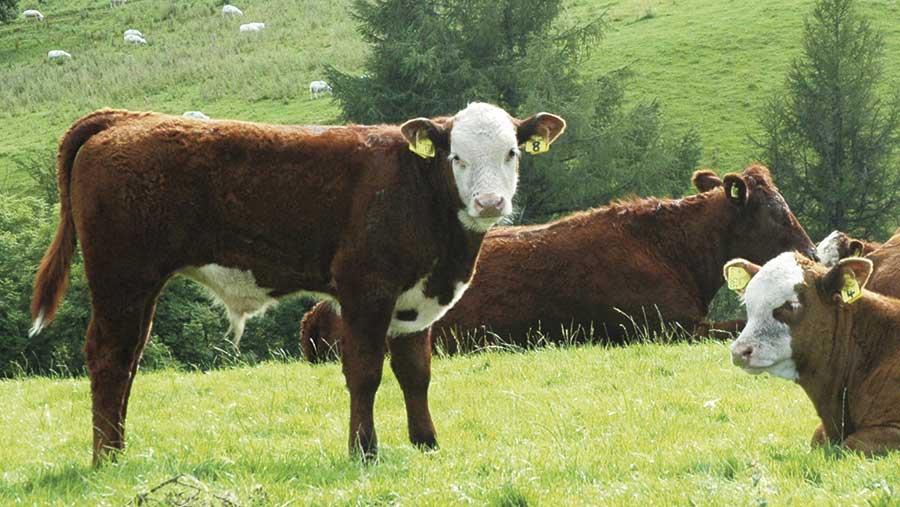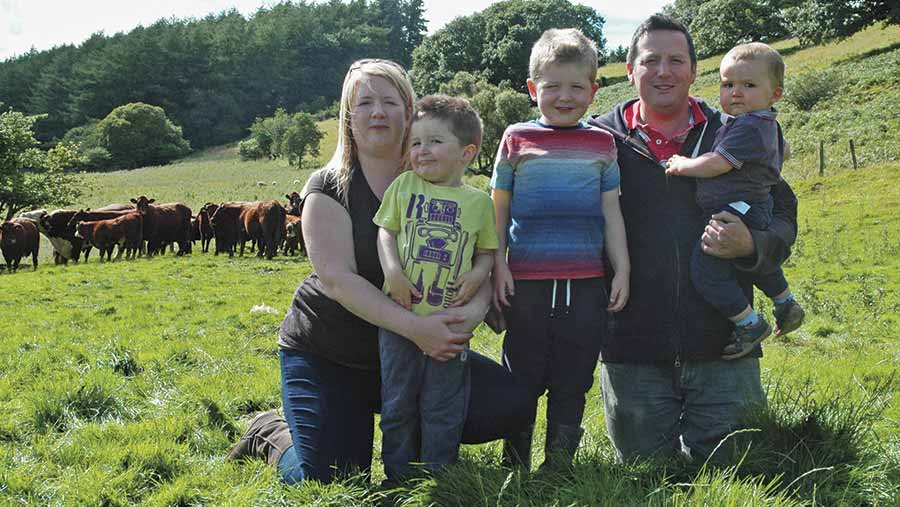How ‘Red Baldy’ cattle lifted beef farm output

An upland beef enterprise is seeing productivity lift and labour fall after settling on a hybrid combination of genetics that produces easy-calving, docile cattle.
Calf mortality and barren rates are improving at Upper House Farm, Knighton, where John and Donald Bright started combining easy-calving Salers dam lines with Hereford bulls in 2014.
The result has been well-tempered and moderate-sized cows (650-700kg), which have produced bulls that averaged 460kg liveweight after eight months (up to 1.6kg daily liveweight gain).
See also: How Harper Adams aims to maximise dairy beef growth rates
Calf mortality and barren rates have halved too. A switch to outdoor calving has reduced labour requirements and four weeks has been shaved off the calving block.
The switch came after a major rethink on the sheep operation, which started in 2006.
See also: Upland beef finisher boosts forage quality

Jennifer and John Bright with sons Harry, James and Tom
The Brights are conscious of the need to increase farm efficiency and reduce labour and feed costs in preparation for a future without a Single Farm Payment post-2020.
“Continuing to reduce inputs and get more out of the farm will be vital as the Single Farm Payment is reduced,” explains John, who farms with his father Donald.
The Brights have already made progress on the sheep enterprise, having introduced Aberfield and Abermax tups and lifted scanning from 120% to 170%.
“We are looking at ways to get more out of the farm. Introducing more ploughing and reseeding with high-sugar leys, together with a rotational grazing system will encourage the swards to be more productive and in turn enable us to carry more stock.”
Upper House Farm
- 210ha lesser favoured area including rented land
- 40 Salers suckler cows
- 10 pure-bred Hereford heifers
- 1,200 breeding ewes plus 250 ewe lambs
- Farming cross-bred ewes (Improved Welsh mountain cross Lleyn tup)
- Altitude 305-480m (1,000-1,580ft)
Productivity
Outdoor calving has helped lower pneumonia and scour issues, reducing calf mortality and lifting the number of calves sold marketed per cow bulled to around 95%.
“We’ve seen 100% calving from the Salers twice with no barrens,” recalls John. “Although this year we had two barren cows and lost two calves. If I can minimise losses like this I am pleased.”
The ultimate aim is to rear bullocks and heifers to 16-18 months old off grass. However, in the first year Hereford-sired calves were finished as bulls at nine months old and sold through Ludlow market where the batch averaged £900 at 460kg.
“We won’t get a native-sired premium when we keep our Hereford-sired bulls entire but they did well for us,” recalls John, who says the hybrid bulls hit the same 460kg weight mark six weeks sooner than the pure Salers bulls did.
Fertility
The natural-service, spring-calving herd has seen its calving period reduce by more than four weeks, with most calves (85%) now born in May.
Red Baldy
The term Black Baldy refers to the white-headed progeny produced by Hereford cattle put to Aberdeen Angus bulls. The cross has been a popular British cross for hybrid vigour and the term is widely used in Australia and New Zealand.
By replacing Angus genetics for Salers cows, the Brights are effectively using the Hereford in a cross-cross breeding policy for hybrid vigour and calmer cattle to produce a red equivalent.
Bulls run with the herd all summer after going in on 25 July and are required to bull 20-25 cows a year.
The farm bought Weybrook 1 Duke in Ludlow in 2014, an extremely easy calving “curve-bender” bull with low birthweights and high growth rates. He was recently sent to the cull market at 10 years old after being a great bull for the farm.
The breeding policy is to criss-cross Hereford and Salers on both cows and heifers, although at 1,250kg, Duke was a little big for the heifers.
“We used to calve indoors from mid-February to mid-May,” says John. “When we used continental bulls such as Limousins we were spending a lot more time and effort pulling calves and calving inside, which also required us to buy in straw.
“Herefords appear to be marginally harder to calve than the Salers,” says John. “We’ve had one backwards Hereford calf but no dramas.”
He rates a tight calving pattern as this gives the farm the ability to market stores in uniform groups at Ludlow market.
“The Salers keep the growth in them – apart from the white face, the calves would pass for continentals. Meanwhile, the Hereford influence makes them docile, which is important as I want to work the cattle myself, calve outdoors and I have a young family.”
Heifers calve at two and are currently being retained at present but the plan longer term could be to market replacements.
Nutrition
A tighter calving block has been achieved with cows on a winter diet of silage and straw. Youngstock receive minimal creep before housing to prepare their rumens for weaning, which happens at housing in November at six months old.
The bulls ate 2.25kg of a 17% crude protein last winter before turnout, explains John. He is trying to reduce the amount of bought-in feed and has already reduced his feed bill by 25%.
“The aim is to do as much as we can from the grass at home.”
Cows receive big baled silage for three days, although clamp silage is made most years. Two days a week cows receive just straw to steady their growth and prevent cows becoming fat.
A high-iodine trace element bolus is given to the herd twice a year in January and July – a post-housing and pre-bulling bolus.
John and Donald have noticed caving get tighter since using the bolus, which also supplies copper, cobalt, selenium, manganese, zinc and vitamins A, D3 and E.
“The idea is they work six months apart and at a cost of £2.20-£2.50 a cow it is a good investment,” adds John, who also invests in a BVD vaccination for the cattle.
Soil fertility and grass
Being a peaty farm and regularly receiving up to 80cm-1m of rainfall a year, the Brights must invest in lime and phosphate applications to keep soil fertility up.
An order of 200t of lime is going down in May to keep pH levels at 6 or above following a soil analysis showing the worst areas were about 5.2 to 5.5. Gafsa Phosphate is ordered on some of the more acidic soils, explains Donald.
“Growing root crops is out of the question up here,” he says. “We are now growing an Italian ryegrass and fodder rape mix that goes down for two years for the sheep, followed by a longer-term ley which will have red clover in it.”
Going forward, more acres are to be ploughed and improved with high-sugar Italian ryegrasses and red clover.
Labour
Polled genetics, easy calving and docile cows are making for a much less labour-intensive herd, which complements the sheep enterprise, which has doubled since 2006.
Polled genetics save on stress on both calf and farmer and remove a growth check, which is saving John Bright time.
More from grass
Using a native sire will give the Brights the option of finishing cattle at grass, with the plan being to take Hereford-sired steers and heifers to 380kg carcass weights at 22 months old.
Alternatively, stores could also be sold at 16 to 18 months after following the sheep grazing excess grass.
“It’s a different mindset to using continental bulls,” admits John. “It’s a slower game, it’s more extensive and you don’t want to spend too much money in getting cattle to where you want them.”
Wildbrook 1 Duke
|
EBVs |
Calving ease direct |
Calving ease Daughters |
Birth weight |
200-day weight |
400-day weight |
200-day milk |
600-day weight |
|
Duke |
+10.1% |
+5.3% |
-0.6kg |
+25kg |
+53kg |
+5kg |
+62kg |
